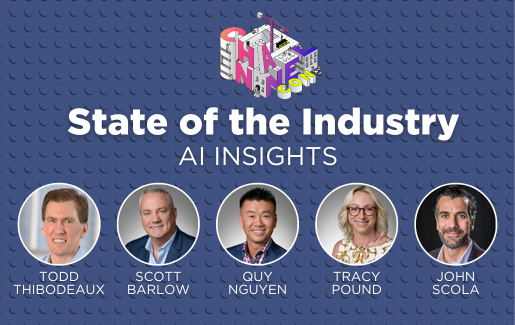 The influx of artificial intelligence (AI) and large language models (LLMs) is poised to have an impact on everything we do. But there’s a long list of questions that every business leader needs to ask themselves before implementing any AI strategies or functions:
The influx of artificial intelligence (AI) and large language models (LLMs) is poised to have an impact on everything we do. But there’s a long list of questions that every business leader needs to ask themselves before implementing any AI strategies or functions:
- Can you implement AI solutions into your operations and your offerings? Should you?
- What are the benefits?
- What are the risks?
- What do my customers want?
So many questions, but not a lot of answers yet in the short time since ChatGPT and other AI-powered applications came to market.
Earlier this year, CompTIA’s board of directors met and discussed how their respective companies were handling AI, a conversation that continued during a keynote session at ChannelCon 2023 in Las Vegas with CompTIA CEO Todd Thibodeaux and several board members.
“It was a conversation we couldn’t have had even three months prior. That’s how fast everything exploded after ChatGPT and other applications came out of the woodwork,” Thibodeaux said. “But what we found was an amazing collection of use cases, challenges, struggles and opportunities.”
The consensus: AI presents a potentially game-changing technology to help businesses improve their operations, profits, supply chains and more. But take a measured approach. Walk before you run, according to Tracy Pound, founder and managing director of MaximITy.
“AI can really help move the IT industry forward. But it must be tempered with how we develop and implement the tools. There are risks,” Pound said.
With Power Comes Great Responsibility
 Of course, AI has been around a lot longer than ChatGPT and everyone’s been using it in some way, perhaps without knowing it. Quy Nguyen, CEO of Allyance Communications, said he started using an AI-powered email and chatbot system five years ago to schedule appointments and reminders.
Of course, AI has been around a lot longer than ChatGPT and everyone’s been using it in some way, perhaps without knowing it. Quy Nguyen, CEO of Allyance Communications, said he started using an AI-powered email and chatbot system five years ago to schedule appointments and reminders.
“Some of my friends thought it came from a real person but it was an AI bot. It was so good at coordinating my schedule,” said Nguyen, who also cited an AI application he now uses regularly that joins Zoom conference calls and generates a summary of the call, with action items, shortly afterwards.
“We also use an application that uploads PDF contracts or NDAs and we ask what I should look for, what the red flags are in this. It outlines them before I send it to lawyers, a shortcut to reduce [legal] billing hours,” he said.
So clearly there are real-world AI applications now in use that can help businesses, but the market and our own ability to understand what AI can do still has to mature, so proceed with caution, said Scott Barlow, vice president of global MSP and cloud alliances at Sophos.
“Previous technologies helped organizations to grow faster and scale. AI will take that to the next level and enable everyone to be more productive,” Barlow said. “But it comes with a lot of risk, more than other applications. I’ve done a lot of research on AI hallucination and, for example, one model used to respond to math questions with 93% accuracy, but now because of human input that’s dropped to 30%. There are legislative issues, intellectual property concerns. It’s cautious optimism that we should all look at it with.”
Businesses considering leveraging AI’s capabilities should focus first on solving the business problem, then determining if or how AI could be an answer, said John Scola, global vice president, software partners, at SAP.
“It’s all based on a certain use case. Where is the productivity gain? Is it going to speed up my supply chain? It takes time to figure out which LLM might be right one for your application. Does the data need to be fine-tuned for the data set you’re going to use? Take your time, figure out your use case and roll that out,” Scola said.
Most companies struggle with improving sales, delivery and finances. Those are areas for which MSPs could leverage AI to help build long-term solutions, said Pound. “You’re looking to deliver operational excellence. Years ago, I had a boss who said ‘Work yourself out of your own job. Then you can go do something better.’ That’s what we should try to do. Get customers self-sufficient and they’ll come back to us for the next thing. That’s a huge opportunity for us all,” she said.
Security Is Serious Business
Security is and should be one of the biggest concerns around AI. As Barlow noted, AI can turn a novice hacker into a serious threat.
“AI can rapidly detect what is a phishing attack and what is not, but hackers can also use it to scan for holes in your network. There’s been a lot of communication around end user training and I think there will be a lot more,” he said.
The board members’ respective companies all have different access controls for employee use of AI and LLMs, but most said any queries need to happen behind a firewall and not include the organization’s intellectual property.
“We’ve selected 10 or so LLMs that employees can use and we have development teams leveraging hyperscale LLMs behind our firewall. Security always needs to be top of mind. We have 400,000 customers so we make sure to put our customers first as opposed to technology first,” Scola said.
Don’t Let AI Supersede the Personal Relationship
As clients become more aware of AI’s capabilities, it’s incumbent to remind them of the risks, but also to continue to deliver solutions with a human touch, said Nguyen.
“We talk a lot about the technology, but the one thing that stands out is we are a people-first, relationship-first kind of business. When there’s an issue, it’s people that tend to resolve it, not AI. It’s escalation, it’s back office, it’s people going above and beyond,” said Nguyen. “That’s how we still approach it. As efficient as we want to make you as an organization, we still want to deal with people.”

 Add CompTIA to your favorite RSS reader
Add CompTIA to your favorite RSS reader

.png?sfvrsn=94790fef_2)